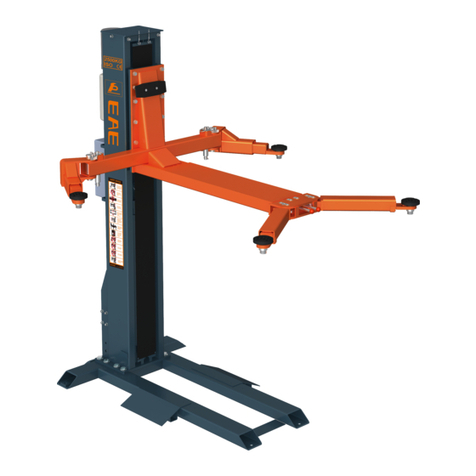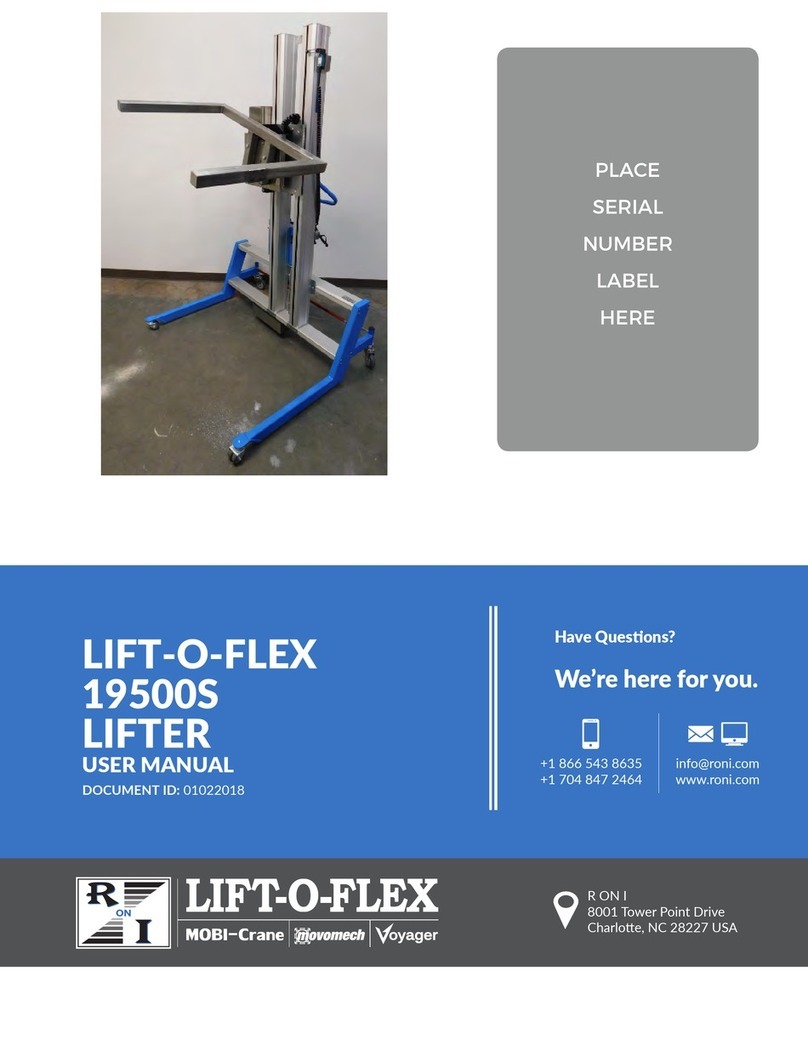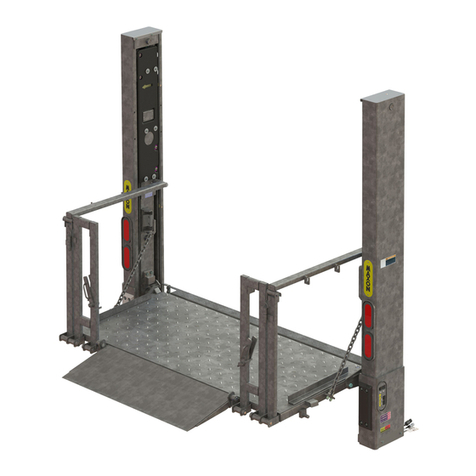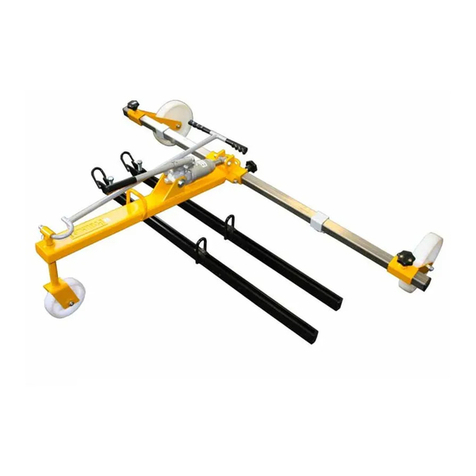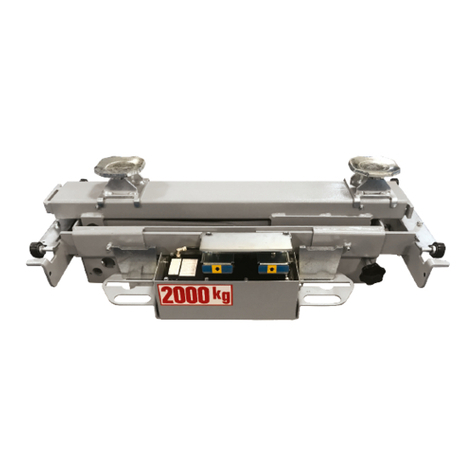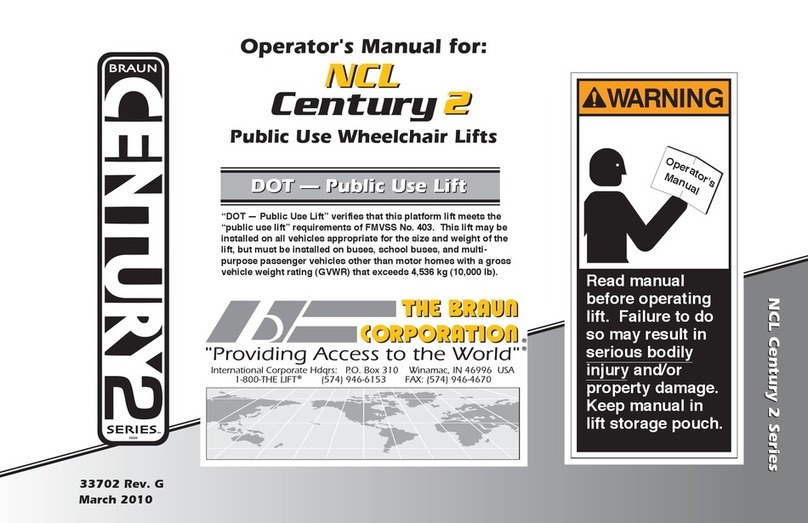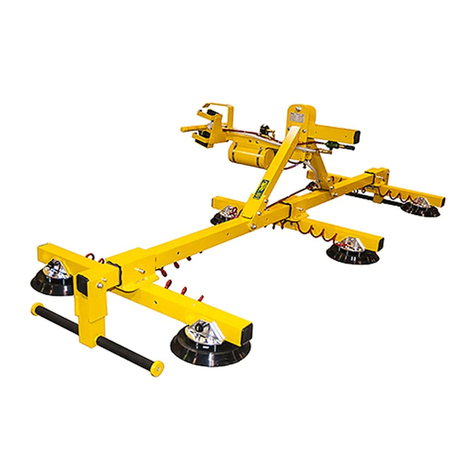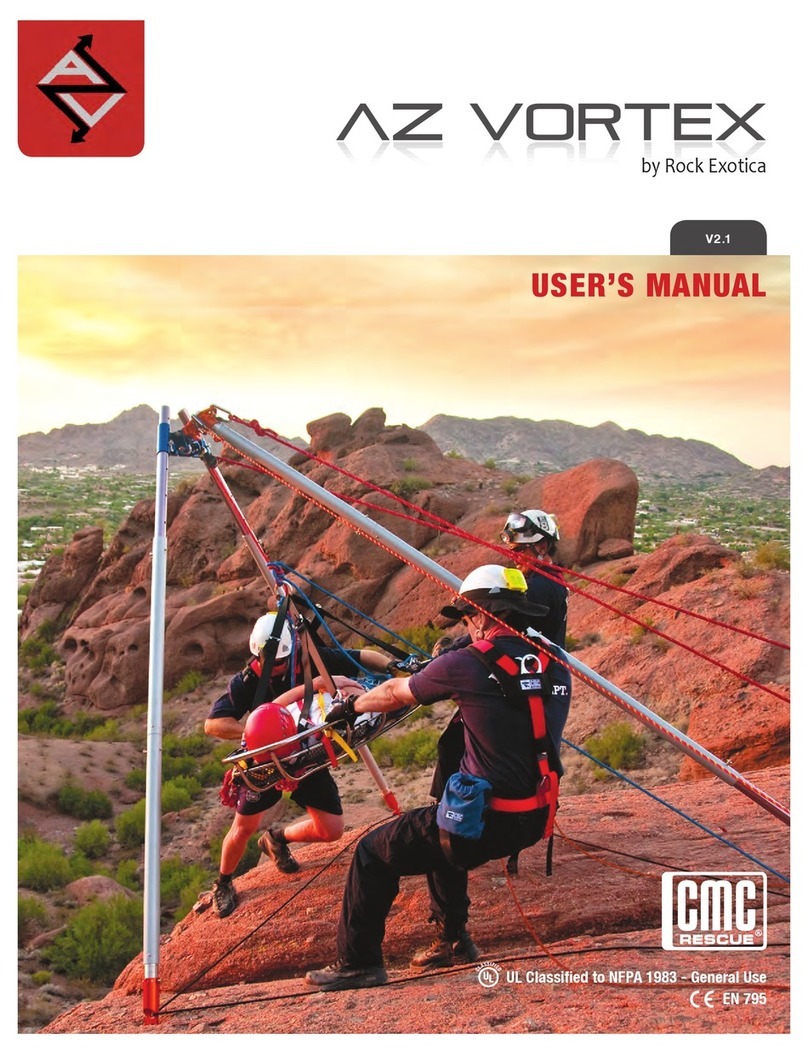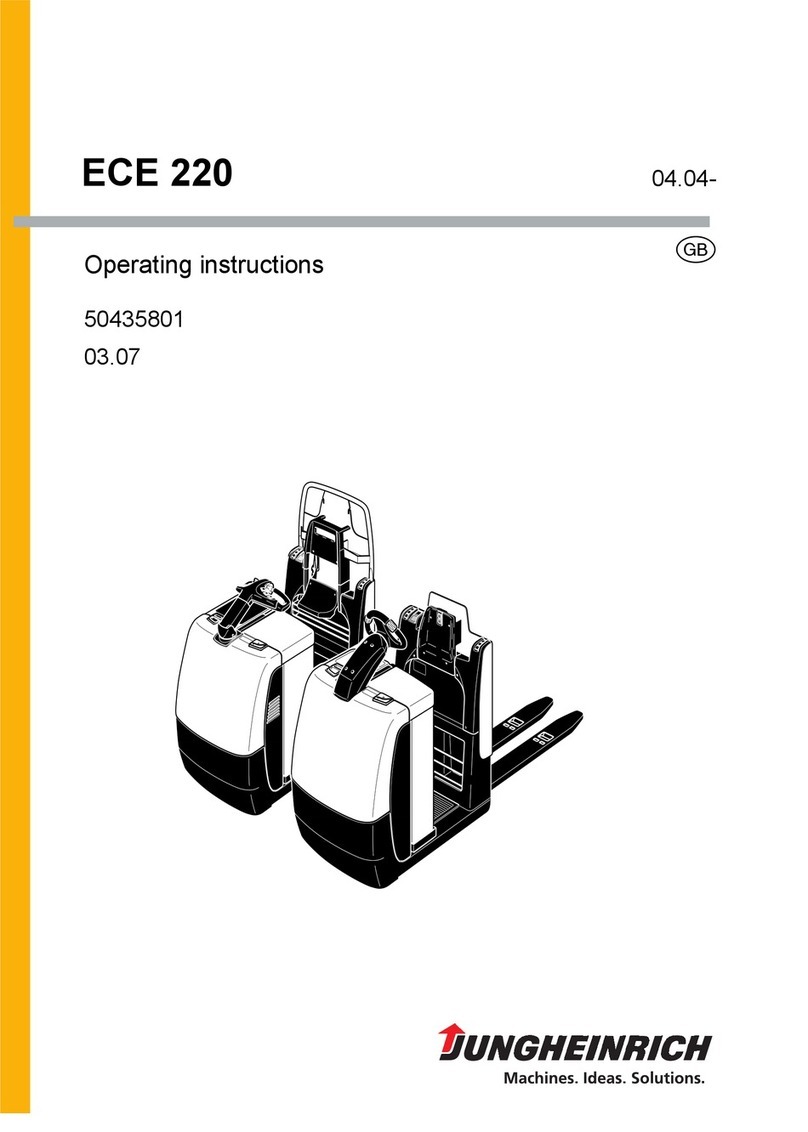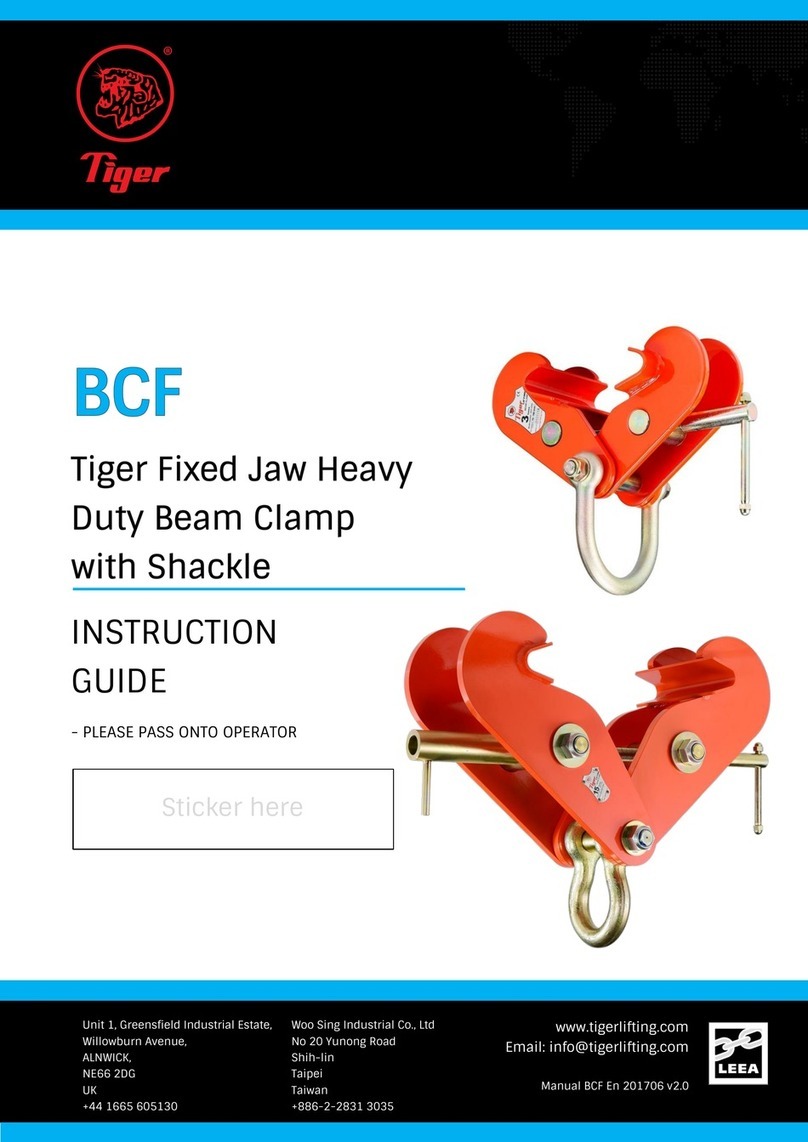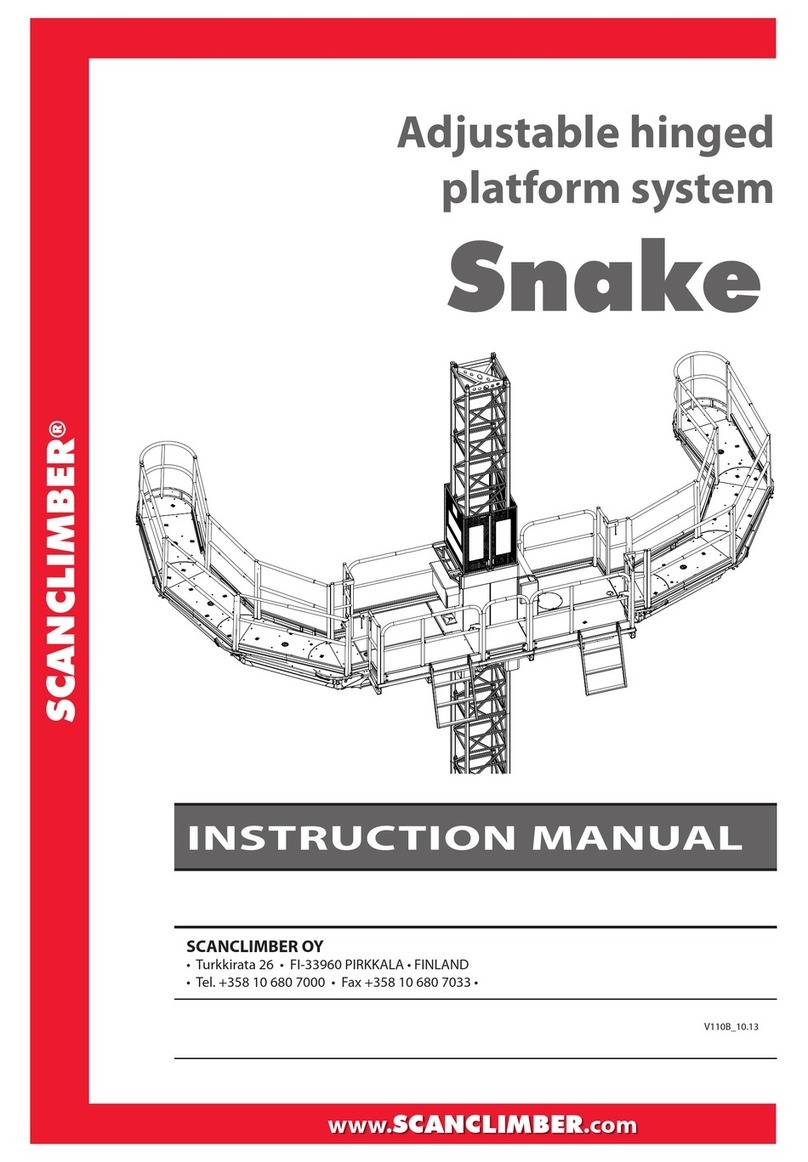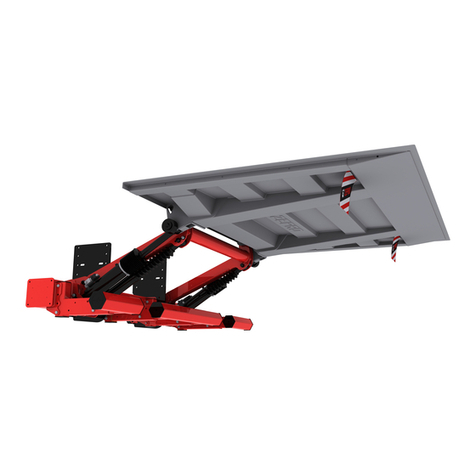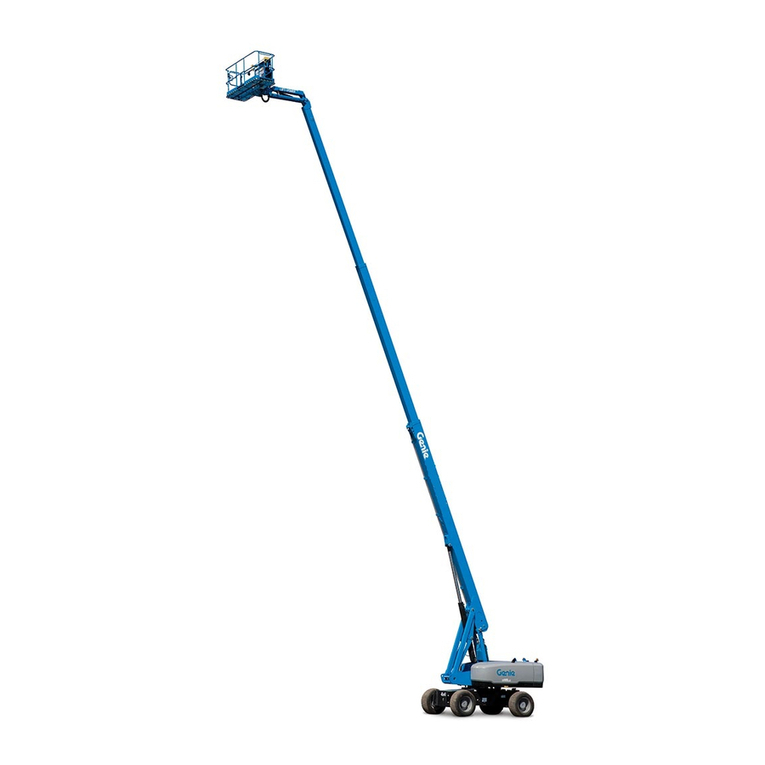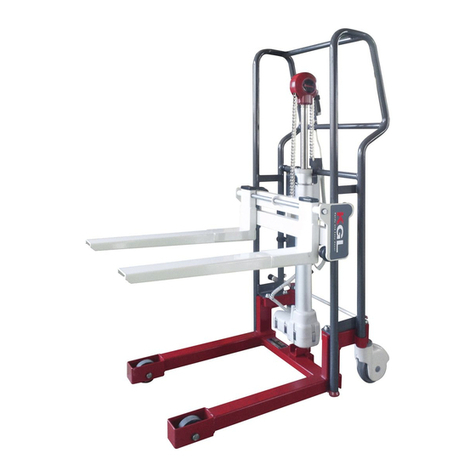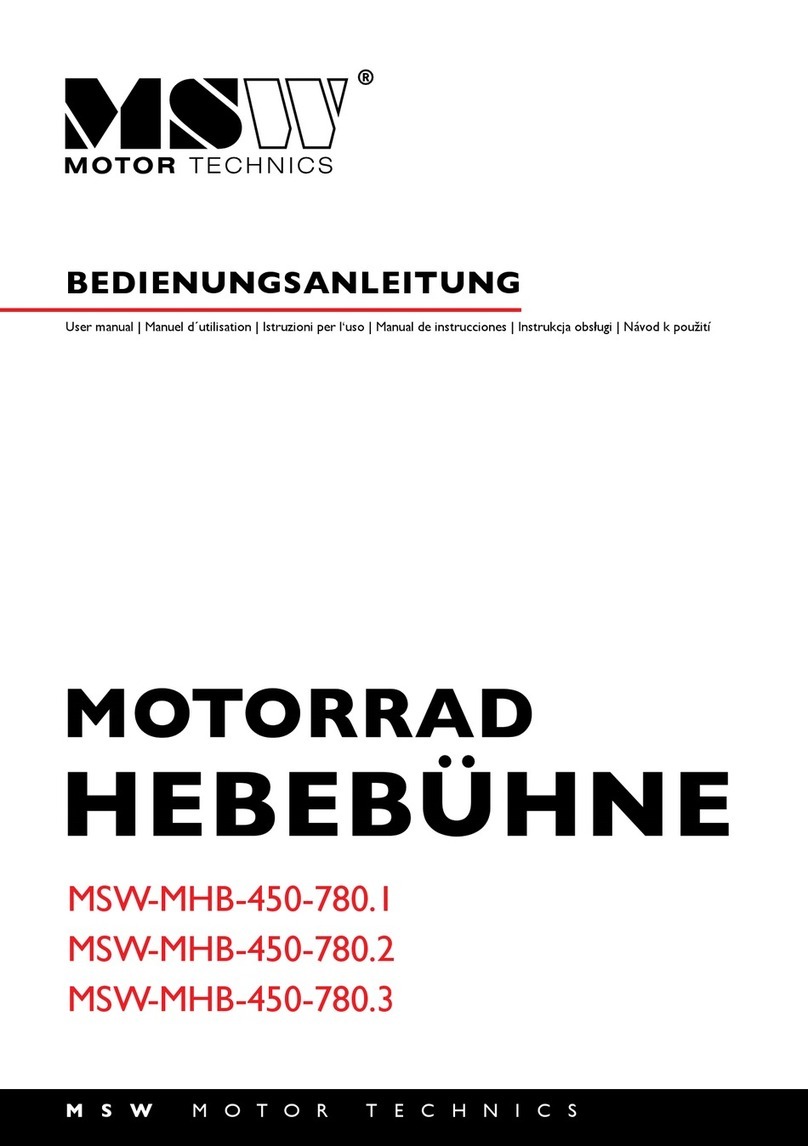FORTA STAND UP HOIST User manual

FORTA’S HOISTS
USER MANUAL
STAND UP HOIST PRACTIKA
MINI


1
• USE INSTRUCTIONS AND CERTIFICATES
• RELEVANT SECURITY NOTES
• SLING
• LEGS OPENING/CLOSING
• WHEELS BRAKES
• EMERGENCY STOP BUTTON
• LIFTING AND DESCENT OF THE PATIENT
• DESCENT OF THE PATIENT WITHOUT CURRENT
• MOVEMENT OF THE HOIST
• CONTROL BOX PLACEMENT
• CONTROL BOX LOCK AND EXTRACTION
• CONTROL BOX CONNECTIONS
• SWAPPING A PRACTIKA INTO A STANDUP AND
VICE VERSA
• ARM SWAP
• FOOTREST ASSEMBLY
• BATTERY CHARGING AND LIFETIME
• ELECTRIC EQUIPMENT PROPERTIES
• RECLYCLING OF THE MATERIALS
• GOOD PRACTICES
• FAILURES AND SOLUTIONS
• GENERAL RECOMMENDATIONS
• MAINTENANCE
• INSPECTION INTERVALS
• WARRANTY AND AFTER-SALES SERVICE
HOISTS USE AND MAINTENANCE MANUAL
2
3
4
4
4
5
5
6
6
7
7
7
8
8
9
10
11
11
12
12
13
13
14
15

2
USE INSTRUCTIONS AND CERTIFICATES
Never use the hoist prior to the reading of this manual and without the
appropriate advice of a professional who explains the using technique
in detail.
Our personal lifting hoists Practika, Mini and Stand up have been
developed to grant the highest stability and comfortability. To do so, we
have designed a double compass system which works on both, front
and rear wheels, opening them all at the same time. This system grants
extra stability when lifting the user.
In addition, our hoists’ arm and legs are all foldable, allowing you to
store the hoist saving space.
All these improvements have been patented
by FORTA, therefore, only our hoists can
offer these huge advantages.
FORTA’s hoists comply with the European
Directive 93/42/CEE concerning medical
devices as well as the CE mark. These
hoists have been tested and homologated
by the Instituto de Biomecánica de Valencia
(IBV) and comply with the ISO 10535
requirements “Hoists for the transfer of
disabled persons – Requirements and test
methods”.
Each and every one of our hoists is strictly
checked in our factory to verify their
operation.

3
RELEVANT SECURITY NOTES
• Before using the hoist, please check that all its components work
correctly.
• Before using the hoist for the first time it is convenient to charge it
from 10 to 24 hours.
• Always make sure that the patient does not exceeds the weight
maximum limit of the hoist. This information is indicated on the
hoist’s arm.
• Do not keep the hoist’s brakes on while lifting the patient.
• Always move the hoist pushing the handles, never push the patient
or the arm of the hoist.
• When moving the patient on the hoist, keep them as close as
possible to the ground to gain stability.
• When moving the patient on the hoist, move it around slowly, turn
the hoist softly and with no abrupt movements.
• Do not use the hoist on a lateral inclination that exceeds 4º. If you
need to do so please look for the help of a third person.
• Never leave the patient lifted on the hoist.
• Do not use the hoist on humid locations.
• Never charge the batteries in a place that is not completely dry.
• Always use the hoist on a flat, clean and dry surface.
• Do not try to overtake 10 mm. or higher obstacles when the user
is on the hoist.
• Always make sure that the front legs fixing pins are placed and
locking the legs before using the hoist.
• Do not allow the patient to swing.
• Never lift the patient only from one side, make sure that the sling is
well placed and holding both sides of the arm of the hoist.
FORTA reserves the right to modify, partially or completely, any piece or
technical data of the hoist without prior notice, as current configurations
of the products are in a constant process of change for improvement.

4
SLING
• Do not use a non-homologated sling.
• Adjust the sling following its use instructions.
• Always check that the sling is adequate for the size of the patient.
• Check the condition of the sling before each use.
LEGS OPENING/CLOSING
1. Place yourself behind the hoist.
2. Grab the handles of the hoist and open the legs by pressing the
bottom pedal on its right position with your foot. All four legs will
open.
3. To close the legs, grab the handles and press the bottom pedal on
its left position.
WHEELS BRAKES
1. Place yourself behind the hoist.
2. Grab the handles of the hoist and press the red piece that is located
on each rear wheel, locking them.
3. To unlock them, just pull the piece to its original position.
ATTENTION
While lifting or descending the patient on the hoist, the
wheels must be unlocked to allow the hoist to adapt and
move to the centre of gravity. If the wheels are locked,
this movement will be absorbed by the patient and could
lead to discomfort and danger.

5
Make sure that the fixing pins of the legs are in the right position, going
through both holes, crossing the leg and locked.
The lifting and descending of the arm will be made always using the
electric motor, handled by a simple control.
The electric controller has two buttons indicating LIFT or DESCEND
using arrows. The hoist stops itself when it reaches the limit in both
directions or if the weight is higher than that allowed and indicated
on the arm of the hoist. A LED will turn on in case of weight overload.
LIFTING AND DESCENT OF THE PATIENT
150kg 130kg
Práctika
Bipedestación
Mini
EMERGENCY STOP BUTTON
At the top of the control box there is a RED
BUTTON that, when pushed, will stop the current
that feeds the hoist. It will only be renovated
when the button is turned following the arrows
indicated on it.

6
DESCENT OF THE PATIENT WITHOUT CURRENT
In the case of the hoist not descending the patient,
either because of overweight or lack of electric
current, the hoist has a security system to descend
the patient safely.
Push the red piece located at the top of the electric
motor’s stem downwards and turn clockwise. This
will make the arm go down slowly.
MOVEMENT OF THE HOIST
1. Place yourself behind the hoist and grab the handles strongly.
2. Open the legs as indicated before on “LEGS OPENING/CLOSING”.
3. Unlock the wheels as indicated before on “WHEELS BRAKES”.
4. Push the hoist from the handles to the desired direction. The hoist
has rotating wheels that ease its manoeuvrability.
The control has a battery capacity indicator which
indicates the charge capacity of the batteries. When
this indicator shows a red light it means that the
batteries have reached their minimum level and
there is risk of damaging them. At that point, end
the manoeuvre and charge the hoist before using it
again.
In case of failure of this control, the control box has
two buttons, up and down, to use the hoist.

7
CONTROL BOX LOCK AND EXTRACTION
Out hoist have their control box on its lateral side to optimize space
and so it is more protected.
CONTROL BOX CONNECTIONS
Insert the connectors thoroughly in their corresponding plug.
Make sure that every plug is connected correctly.
The control box is installed on the hoist. Nevertheless, follow this as-
sembly instructions if necessary:
CONTROL BOX PLACEMENT
Control
Actuator
Charge wire

8
SWAPPING A PRACTIKA INTO A STANDUP AND
VICE VERSA
Theres is an option to turn our Practika hoist into a Stand up hoist and
vice versa. To do so you may have to purchase an extra product as it
is not a standard option.
ARM SWAP
• Using the knob system, dismantle the arm that is installed on the
hoist and place the other arm and each component as shown
below.
• Advise with your provider before going through this change as a
bad assembly may result in a bad performance of the product.
• Once every piece is in place, tighten up the knobs until they are
locked.
• When the knobs are locked, with the motor unplugged, the arm
should be loose and easily moved with your hands.
• Check daily the adjustment of the knobs.
Do not modify the sequence of the assembly
CHANGING THE ARM OF A MINI HOIST IS
FORBIDDEN

9
FOOTREST ASSEMBLY
Assembly the footrest platform on the bottom crossbar of the hoist,
inserting the screws with their nuts and tighten them up from the pedal
part, where the opening of the legs mechanism is.
Tighten the nuts firmly so the footrest does not move when used.
Insert the second part of the footrest, where the knees should be
sustained, in its hole and fix its height using the knob.
Be careful about entrapments.

10
BATTERY CHARGING AND LIFETIME
Strong and frequent discharges reduce the lifetime of the battery. For
an optimum lifetime the batteries should be recharged as often as
possible. The minimum recharging time must be of 8 hours.
If the hoist is use daily it is convenient to recharge the batteries during
the night. The control box has an automatic device that turn off the
charging when it has reached full charge.
To start charging, check that all connectors are as specified in
“CONTROL BOX CONNECTIONS”.
The batteries are the only components that need a continuous
maintenance. If this manual is not followed the batteries may discharge
to a level where they may not get their original maximum charge or
can even become inoperative.
The batteries can be found inside the battery box. The control box
beeps softly when batteries must be charged and a red led will light on
the control. At that time, finish the maneuver and charge the batteries
following the instructions below as they have reached their lowest char-
ging level and if you keep using them they might be damaged:
• Connect the charger wire in its plug at the bottom of the control
box.
• Make sure that the emergency red button is not pressed.
• Plug the cable to the current supply (220 V).
• The average charging time is 12 hours and the charger will be
disconnected from the current automatically when fully charged.
• If the hoist is not used, it is necessary to charge it completely once
a week to keep the batteries from damaging due to their own self-
discharging.
• Once the battery is charged, unplug first the cable from the power
supply and, then, from the hoist.

11
ELECTRIC EQUIPMENT PROPERTIES
The control box has a security mechanism that stops the hoist after
completing around 8 straight cycles restlessly. Then, the hoist must rest
to avoid damaging the equipment. If this cycle is exceeded there is a
risk of a breakdown due to overheating.
When this cycle is reached it does not mean that the hoist is uncharged,
but that the user must wait to use the hoist again as it needs some time
to recover.
Never use the hoist during the charging of the batteries.
Lifetime of the batteries will depend on the discharging percentage
they suffer after each use. This is why you should not let them discharge
completely.
RECYCLING OF THE MATERIALS
This hoist is made of steel profiles with epoxy covering so to dispose of
it you should follow the local recycling ordinances.
In the case of the batteries, they contain lead (Pb) and they must be
deposited in the recycling bins intended for car batteries or taken to the
appropriate waste recycling manager.

12
GOOD PRACTICES
• Charge the batteries during night hours when the hoist has been
used during the day.
• Charge the batteries immediately after hearing the beep indicating
low battery and/or checking the red light LED on the control.
• Charge the batteries in a dry and ventilated area.
• Keep the hoist with its batteries fully charged.
• Avoid completely discharging the batteries.
• If the hoist is not going to be used for a long time, remember to
charge the batteries frequently, at least once per week.
• Do not keep the charger cable connected to the hoist if it is not
going to be charged immediately.
FAILURES AND SOLUTIONS
FAILURE CAUSE SOLUTION
Hoist won’t lift. Red button pressed. Deactivate red
button.
Bad cable
connections.
Connect correctly.
Uncharged batteries. Charge batteries.
Faulty controller. Replace controller.
Hosit stops when
lifting the user.
Overweight. Reduce weight.
Uncharged batteries
(beeping).
Charge batteries.

13
GENERAL RECOMMENDATIONS
Below are indicated some of the most frequent maintenance operations:
• Keep the hoist clean and in perfect condition following the
instructions of this manual.
• Use maintenance products like lubricant oils, sprays, we cloths, etc.
and non-aggressive products like neutral detergent or alcohol.
• Do not use solvents that could damage the covering of the hoist.
• It is advisable to grease frequently all the parts of the hoist where
there is movement. This will improve its performance and avoid
wearing of the pieces.
• Avoid accumulation of dirt in moving parts of the hoist.
• Do not use the hoist in high humidity areas.
• Do not charge the batteries in the bathroom.
MAINTENANCE
A preventive maintenance made frequently will make the hoist be kept
in the best condition for the longest time and, at the same time, small
problems can be found and solved in time, before they evolve into
important damages. Thus, maintenance grants better security day by
day and, in the long term, savings in time and money.

14
DAILY WEEKLY
EVERY 6 MONTHS MONTHLY
• Cleaning.
• Check the tightening of the kn-
obs, screws and nuts.
• Legs lock.
• Brakes.
• Security clips check.
• Existance of cracks.
• Greasing.
• Sling.
• Bearings.
• General inspection.
INSPECTION INTERVALS
NOTE: Never get the hoist wet with water, acids, chlorine
or any other liquid, as it could damage its mechanical
or electric part.
ADVERTENCIA
Below is showed the adequate maintenance
due over each component of the hoist
indicating the time interval for which they
should be checked.

15
WARRANTY AND AFTER-SALES SERVICE
Conditions:
The warranty valid period will start on the purchase date and will be of
2 years for the structure and components and 1 year for the batteries,
as long as these conditions are met:
• Only original FORTA hoists bought in authorised establishments
will be covered by the pieces and manufacturing warranty.
• In case of anomaly, the purchasing establishment must notify it
immediately.
• FORTA will not be responsible of faults caused by an incorrect
manipulation, negligence or by no respecting the instructions of
this manual.
• During the warrany period, any piece that is faulty due to materials
or assembly mistakes will be repaired and replaced by FORTA free
of charge.
• Any modifications or regulations done to the hoist or the using of
non-correspondent pieces will automatically void the warranty.
• This warranty does not cover oxidation damages dealt caused by a
bad or negligent use.
THIS WARRANTY DOES NOT COVER:
THE CONSEQUENCES OF A LOGISTIC PROBLEM,
SPECIFICALLY THOSE THAT CONCERN TRANSPORT,
LOSS OF PROFIT, EXPENSES, ETC.
THIS WARRANTY ALSO DOES NOT COVER:
• Opening of the control box and
batteries box.
• Natural wear of the equipment.
• Inappropriate or wrong use.
• Assemblies or repairs carried out by the
buyer or a third person.
• Negligent use.
• Using non-original pieces.
• Non-official workshops repairs.
ADVERTENCIA

16
CONTRACTUAL WARRANTY
FORTA, S.L., guarantees this product for two years from
date of purchase, covering any construction fault related
with the materials or the assembly. This warrany does not
include the batteries.
Any shipping costs for the repairing will be paid by the client.
APPLICATION CONDITIONS
The guarantee certificate must be sent to FORTA, S.L. with a
copy of the invoice within a period of 15 days after completing
the purchase.
The customer must submit the certificate with the seal of the
establishment.
EXPECPTIONS
This warranty will not be applied in case of:
• Opening of the control box and batteries box.
• Natural wear of the equipment.
• Inappropriate or wrong use.
• Assemblies or repairs carried out by the buyer or a third
person.
• Negligent use.
• Using non-original pieces.
• Non-official workshops repairs.
WARRANTY CONTROL
Buyer’s name and surname Age
Address Nº Floor
City ZIP Code
Province Purchase date
Establishment name Purchase date
Establishment signature and seal.
Attention: This document will not be valid if not accompanied with a copy of the appropriate invoice.
FORTA reserves the right to modify partially or completely the products shown at this website with no prior notice.

17
Name of the establishment Purchase date
Signature and seal of the establishment.

Revisión: Enero de 2019 - Referencia 5910.1401
Sent to this direction:
FORTA
FABRICACIONES ORTOPÉDICAS ALBACETE, S.L.
Pq. Emp. Campollano
Calle C nº 90 Nave 1
Apartado de Correos 5316
02007 ALBACETE
SPAIN
This manual suits for next models
2
Table of contents
